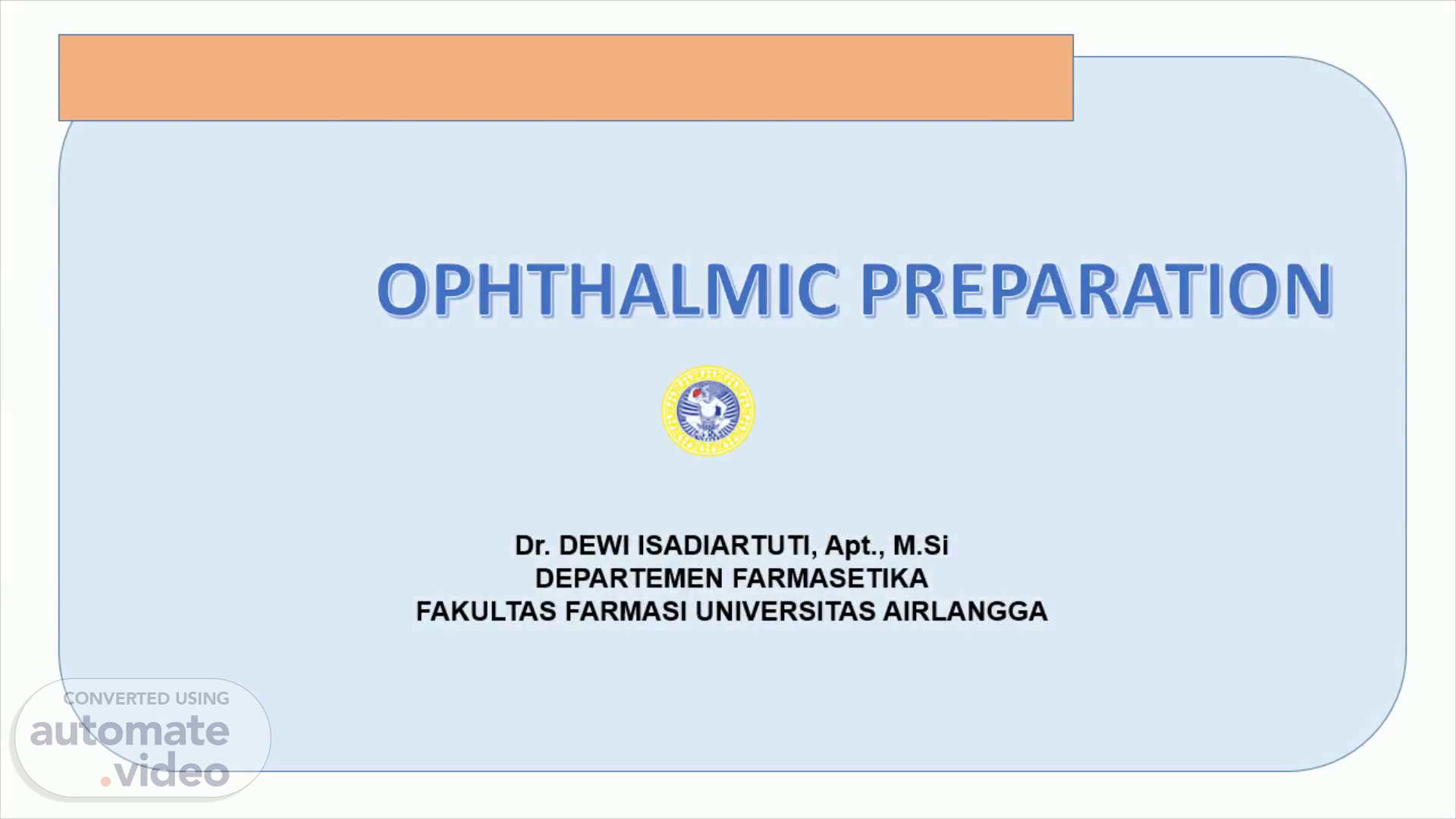
Page 1 (0s)
Dr. DEWI ISADIARTUTI, Apt., M.Si DEPARTEMEN FARMASETIKA FAKULTAS FARMASI UNIVERSITAS AIRLANGGA.
Page 2 (10s)
EYE DROPS. Sterile solutions or suspensions of one or more drugs in an aqueous or oily vehicle intended for instillation into the conjunctival sac diagnostic and therapeutic purposes - contain drugs which act on the anterior segmen of the eye: the cornea, conjunctiva and anterior uvea - drug acting : a. antimicrobials agents ( antibacterials , antifungals, antivirals) b. artificial tears c. corticosteroids and NSAID agents d. cycloplegics e. diagnostic f. glaucoma, local anasthetics , miotics and mydriatics.
Page 3 (1m 22s)
EYE DROPS. PREPARATION OF EYE DROPS 1. Preparation of the solution 2. Clarification of the solution 3. Filling and sterilization (Volume: 5-10 mL) Labelling of container 1. Fully identify the product 2. Specify the conditions of storage 3. State expiry date 4. Include the warning 5. Specify the volume of the preparation 6. Ensure correct use.
Page 4 (6m 22s)
EYE LOTIONS. Sterile aqueous solutions used undiluted for washing or bathing the eyes The purpose of eye lotions is to assist in the cleaning of the external surfaces of the eye. This might be to help remove a non-impacted foreign body or to clean away conjunctival discharge. Eye lotions intended for use in surgical or first-aid procedures should not contain antimicrobial preservatives and should be in single-use containers. There is no intention to use an eye lotion to deliver any active ingredient to the eye but rather to remove unwanted gross contaminants from the eye..
Page 5 (7m 27s)
EYE LOTION. Thus these preparations should be very simple and the most common eye lotion consists of sterile normal saline. This preparation typifies the requirements of an eye lotion which are: Sterile and usually containing no preservative Isotonic with lachrymal fluid Neutral pH Large volume but not greater than 200mL Non-irritant to ocular tissue.
Page 6 (8m 48s)
EYE OINMENTS. Sterile, semi-solid preparations of homogeneous appearance containing one or more drugs intended for application to the conjunctival sac or eyelid margin Eye ointments must be sterile and may contain suitable antimicrobial preservatives, antioxidants and stabilizers. It is necessary also that such ointments are free from particulate matter that could be harmful to the tissues of the eye. The EP and BP have limits for the particle size of incorporated solids which will be met if all particles have been reduced to <25micron..
Page 7 (9m 51s)
EYE OINTMENT. Ointments have the disadvantage of temporarily interfering with vision, but have the advantage over liquids of providing greater total drug bioavailability. However, ointments take a longer time to reach peak absorption The basic components of an eye ointment are given below: Liquid paraffin 1 part Wool fat 1 part (to facilitate incorporation of water) Yellow soft paraffin 8 parts Hard paraffin as required to produce required consistency in hot climates.
Page 8 (11m 12s)
EYE OINTMENT. - used for therapeutic and diagnostic purposes such as antimicrobials agents (antibacterial and antivirals), corticosteroids and NSAID, mydriatics considered a logical extension of viscolized eye drops and employed prolonged contact time should be sterile, free from particulate contamination, stability the use collapsible tubes for eye ointments ensures that there is no air space (weight 3.5 – 5 gram).
Page 9 (12m 48s)
PREPARATION OF EYE OINTMENT. Eye ointments prepared using aseptic techniques a. by incorporating the finely powdered medicament or b. sterilized concentrated aqueous solution of medicament into the sterile eye ointment basis The eye ointment basis are heated together and filtered while hot through a coarse filter paper in a heated funnel into a container which will withstand dry heat sterilization After preparation, the eye ointment is transferred to the final sterile container..
Page 10 (16m 19s)
. CONTACT LENS PRODUCTS. Product used in the care of contact lenses include: Rinsing Saline solutions for soft lenses should have a neutral pH and be isotonic with human tears, that is, 0.9% sodium chloride, facilitate lens hydration, preventing the lens from drying out and becoming brittle. for storage, some saline solutions contain preservatives. b. Cleaning Surfactants, which emulsify accumulated oils, lipids, and inorganic compounds, and enzymatic cleaners The ingredients in these cleaners usually include a nonionic detergent, wetting agent, chelating agent, buffers, and preservatives c . Soaking Soaking solutions contain a sufficient concentration of disinfecting agent, usually 0.01% benzalkonium chloride and 0.01% edetate sodium, to kill surface bacteria. d. Wetting solutions Typical ingredients include a viscosity-increasing agent, such as hydroxyethyl cellulose; a wetting agent, such as polyvinyl alcohol; preservatives, such as benzalkonium chloride or edetate disodium; and buffering agents and salts to adjust the pH and maintain tonicity..
Page 11 (19m 24s)
SOLID DOSAGE FORMS. Ocular insert: sterile solid or semi solid preparation with a thin, flexible and multilayered structure, for insertion in the conjunctival sac Advantages ; Increasing contact time and improving bioavailability Providing a prolong drug release → better efficacy Reduction of adverse effects Reduction of number administration → better patient compliance.
Page 12 (20m 30s)
SOLID DOSAGE FORMS. Insoluble insert : ethylene/vinyl acetate membrane pilocarpine reservoir titanium dioxide – white ring.
Page 13 (21m 21s)
SOLID DOSAGE FORMS. The rate of drug diffusion is controlled by: The polymer composition The membrane thickness The solubility of the drug.
Page 14 (22m 17s)
EVALUATION. Sterility test Clarity test Leaker test Metal particles in ophthalmic ointment Volume/weight Stability.
Page 15 (24m 35s)
ADMINISTRATION. tetes mata. salepmata.
Page 16 (26m 22s)
REFERENCES. Pharmaceutical Practice, Collet & Aulton , 1990 Fastract , Pharmaceutics Dosage Form & Design, David Jones, 2008 Remington, Essential Pharmaceutics, Linda felton , 2012 Farmakope Indonesia V, 2014. Ansel ‘s Pharmaceutical Dosage Forms and Drug Delivery Systems, Allen LV & Ansel HC, 2014.
Page 17 (26m 31s)
TERIMA KASIH.